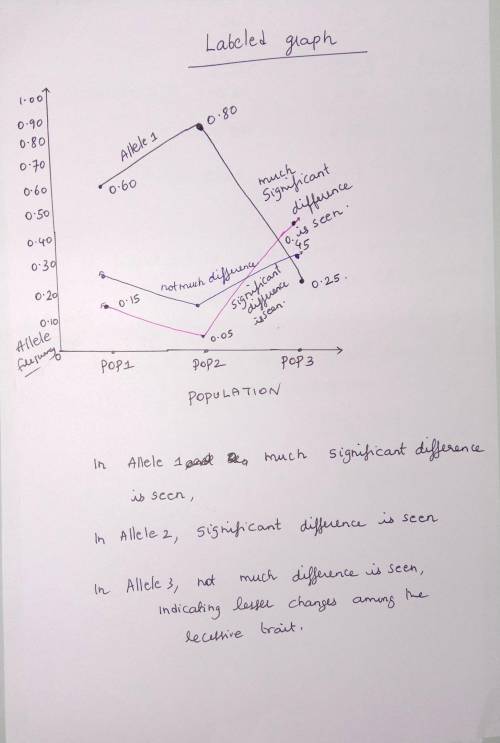
Biology, 21.05.2021 17:10 87haymaker
Scientists interested in the relationship among vision, foraging for food, and fitness studied three isolated populations of a small species of primate whose diet includes small insects and fruit, both of which the animals primarily identify by sight. The three populations were once part of a larger population that was fragmented as a result of habitat destruction by humans. The study populations were selected on the basis of the significantly different vegetation among their current habitats. The scientists analyzed the frequency in each population of each of three alleles of a gene encoding an opsin protein. Opsin proteins are important for color vision, and each allele provides maximum sensitivity to a specific wavelength of visible light and thus to certain colors. Analysis of the alleles present in each population was performed in two different ways, and the data were combined to calculate the frequencies (Table 1).
Table 1. Frequency of opsin alleles in three populations of a small primate
Frequency (±2SEx¯)
Population 1 Population 2 Population 3
Allele 1 0.60 (.05) 0.80 (.06) 0.25 (.02)
Allele 2 0.15 (.02) 0.05 (.01) 0.45 (.03)
Allele 3 0.25 (.02) 0.15 (.02) 0.30 (.02)
(a) Describe one measure of evolutionary fitness.
(b) Using the template, construct an appropriately labeled graph to represent the data in Table 1. Based on the data, determine whether there is a significant difference in the frequency of EACH allele among the three primate populations.
Question 3
(c) Based on the data, identify the population that is likely to have the highest frequency of heterozygotes. Assuming random mating, calculate the frequency of animals in population 1 that carry both alleles 1 and 3.
Question 4
(d) A sudden event drastically changes the habitat of each population such that most of the normal vegetation and insects are replaced by other vegetation and insects. One of the scientists claims that population 2 will be the most severely affected. Predict the most likely effect of the event on population 2. Provide reasoning to justify your prediction.

Answers: 2


Another question on Biology


Biology, 22.06.2019 03:20
Which food could be transported in a galvanized metal container?
Answers: 2

Biology, 22.06.2019 05:30
If a strand of dna has 35% thymine. what is the percentage of cytosine, adenine, guanine?
Answers: 3

Biology, 22.06.2019 06:50
The kidney filters potentially toxic substances in the blood, and thus “clears” the blood of those substances. this clearance function is dependent upon and proportional to the diffusion gradient of the substance across filtering capillaries, i.e. if the concentration of the substance is doubled, twice as much will be cleared from each ml of blood that is filtered. suppose that the body produces a constant amount of a substance x per unit of time. the kidneys eliminate substance x at a rate directly proportional to the concentration of the substance and the volume of blood cleared each minute (c): elimination = c × [x], where [x] is the steady-state concentration of substance x. imagine an individual with an initial concentration of x equal to [x]0 who develops kidney disease. her baseline clearance c0 drops to one half of the original (½c0). what is the new steady state concentration of x? (for simplicity, assume that substance x is 100% filtered by the kidney).
Answers: 1
You know the right answer?
Scientists interested in the relationship among vision, foraging for food, and fitness studied three...
Questions



Mathematics, 17.12.2021 03:30


Computers and Technology, 17.12.2021 03:30



















